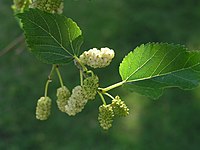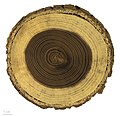マグワ
| マグワ | |||||||||||||||||||||
|---|---|---|---|---|---|---|---|---|---|---|---|---|---|---|---|---|---|---|---|---|---|

| |||||||||||||||||||||
| 分類 | |||||||||||||||||||||
| |||||||||||||||||||||
| 学名 | |||||||||||||||||||||
| Morus alba L., 1753 | |||||||||||||||||||||
| シノニム | |||||||||||||||||||||
| |||||||||||||||||||||
| 和名 | |||||||||||||||||||||
| 真桑 |
マグワ(Morus alba)は、成長が早いクワの一種で、10-20mの高さまで成長する。ヒト程度の比較的短寿命の木であるが、250歳を超える個体もいくつか知られている[1]。中華人民共和国中央部に自生し[2]、アメリカ合衆国、メキシコ、オーストラリア、キルギスタン、アルゼンチン、トルコ、イラン、インド、その他多くの国で栽培されたものが帰化している[3][4][5][6][7][8]。
絹の商業生産に必要なカイコを飼育するために、広く栽培されている。また、音速の半分という速さで花粉を射出することでも知られている[9]。果実は、熟すと食用になる。
記載[編集]

若木では、葉の大きさは最大30cmの長さになり、深く複雑な裂片を持つ丸い形である。古い木では、葉の大きさは5-15cmで、裂片はなく、根元の部分はハート形であり、先端は丸か尖っており、葉縁は鋸歯状である。通常は温帯では落葉性であるが、熱帯では常緑のものもある。
花は単性で尾状花序であり、雄花は2-3.5cm、雌花は1-2cmの長さである。通常、雄花と雌花は別の木に生じるが、1本の木に両性の花が生じることもある[10][11]。果実は、長さ1-1.5cmである。野生のものは深紫色でるが、栽培されたものでは、多くは白色から桃色になる。味は甘いが、強い風味を持つレッドマルベリーやクロミグワとは異なり、風味は弱い。果実を食べた鳥等により、種子は広い範囲に運ばれる[3][4][12]。
科学的には、尾状花序から花粉を放出する際を含め、RPM(植物の急速運動)の事例として有名である。雄蕊がカタパルトとして働き、25マイクロ秒の間に蓄えた弾性エネルギーを放出する。その結果、動きの速さは音速の約半分、610km/hに達し、植物界の既知の運動の中で、最も速いものとなっている[9]。
分類[編集]
- Morus alba var. alba
- Morus alba var. multicaulis
栽培[編集]

中国では、4700年以上前から、カイコの飼育のためにマグワを栽培してきた。古代ギリシアや古代ローマでもカイコの飼育のために栽培された。少なくとも220年には、ローマ帝国皇帝ヘリオガバルスは絹のローブを着用していた[13]。12世紀にはヨーロッパの他の国にも伝わり、15世紀にスペイン帝国に征服された後には、ラテンアメリカにも導入された[14]。2002年には、中国国内において6260km2がこの種のために用いられていた[4]。
インド亜大陸西部から[4]アフガニスタン、イランを経て南ヨーロッパに至る広い範囲で、1000年以上にわたり、カイコの飼育のために栽培されてきた[12]。
最近では、北アメリカの多くの都市部に加えて、道端や植林地の端等の荒れた土地でも広く帰化しており、原生するレッドマルベリーと交雑している。いくつかの地域では広範な交雑が起きており、レッドマルベリーの長期的な遺伝的生存が危惧されている[15]。
標高4000mまで生存でき、温帯の他、亜寒帯地域においても栽培されて広く帰化している。貧土壌にも耐えることができるが、弱酸性で水はけが良い砂質または粘土質のローム土を好む[14]。
利用[編集]

葉は、カイコが好む餌として用いられる他、乾期の植物が少ない地域では、ウシやヤギ等の家畜の餌としても用いられる。大韓民国では、桑の葉茶(ポンイプチャ)が作られる。実も食用となり、しばしば乾燥させたりワインが作られる[4][12]。
アメリカ合衆国では、造園用途で、絹生産のためのマグワからのクローンとして、果実をつけないマグワが開発されている。果実なしで木陰を作ってくれる鑑賞樹として用いられている[16]。
シダレグワ(Morus alba f. pendula)は、鑑賞樹として人気が高い[17]。1800年代末から1900年代初めにかけて、デラウェア・ラッカワナ・アンド・ウェスタン鉄道のニュージャージー州内のいくつかの大きな駅では、この植物が植えられた。影ができることと甘い実を付けることから、アメリカ合衆国南西部の砂漠都市では、芝生に植えられる木として人気があった[18]。一方、花粉に悩まされる都市も多く、花粉症を増やしたとして非難もされた[19][20][21]。
医療用途[編集]
クワノンG、モラシンM、ステポゲニン-4'-O-β-D-グルコシド、マルベロシドA等の様々な抽出成分が広範な薬効を持つと言われている[22][23][24][25][26][27][28][29][30][31][32]。マグワから抽出されるシアニジン-3-O-β-D-グルコピラノシド及びサンゲノンGは、動物モデルにおいて、中枢神経系に対するいくつかの効果が実験されているが、まだその効果を確認する臨床試験が必要である[33]。
生理活性物質としてアルカロイドやフラボノイドを含み、伝統中国医学でも用いられている[34][35]。研究により、これらの化合物は高コレステロール、肥満、ストレス等を減らす効果を持つことが示唆されている[36]。
文化[編集]
- 14世紀中国で書かれた『三国志演義』では、劉備の家に大きなマグワの木があったとされる。
- 1986年の韓国の官能映画『桑の葉』は、この植物から名付けられた。
- 中国語の成語「桑田碧海」は、物事が大きく変わる例えとして用いられる。
ギャラリー[編集]
-
果実のならない木
-
ロングウッドガーデンにあるペンシルベニア州一のマグワ
-
春の葉と雄花
-
様々な形の葉
-
花(インド)
-
葉と花(スペイン)
-
果実(インド)
-
'Pendula'(イラン)
-
イスラエルで絹産業を立ち上げようと1922年にエドモン・バンジャマン・ド・ロチルドが植えた木
出典[編集]
- ^ “The thickest, tallest, and oldest white mulberry trees (Morus alba)”. 2021年11月6日閲覧。
- ^ “Morus alba L.”. Plants Of the World Online. 2021年3月31日閲覧。
- ^ a b c Wu, Zhengyi; Zhou, Zhe-Kun; Gilbert, Michael G. "Morus alba". Flora of China. Vol. 5. eFloras.org, Missouri Botanical Garden, St. Louis, MO & Harvard University Herbaria, Cambridge, MAより2013年6月27日閲覧。
- ^ a b c d e Suttie, J.M. (undated). FAO Report: Morus alba L.
- ^ Wunderlin, Richard P. (1997). "Morus alba". In Flora of North America Editorial Committee (ed.). Flora of North America North of Mexico (FNA). Vol. 3. New York and Oxford. eFloras.org, Missouri Botanical Garden, St. Louis, MO & Harvard University Herbaria, Cambridge, MAより。
- ^ "Morus alba". County-level distribution map from the North American Plant Atlas (NAPA). Biota of North America Program (BONAP). 2014.
- ^ Atlas of Living Australia, Morus alba L., White Mulberry[リンク切れ]
- ^ SEINet, Southwestern Biodiversity, Arizona chapter photos, description, distribution map
- ^ a b Taylor, Philip; Gwyneth Card; James House; Michael Dickinson; Richard Flagan (2006-03-01). “High-speed pollen release in the white mulberry tree, Morus alba L”. Sexual Plant Reproduction 19 (1): 19–24. doi:10.1007/s00497-005-0018-9.
- ^ Schaffner, John H (1919-05). The Nature of the Diecious Condition in Morus Alba and Salix Amygdaloides. 19. pp. 409-416. ISSN 0030-0950.
- ^ Purdue University. Center for New Crops & Plant Products. NewCROP: Morus alba.
- ^ a b c Bean, W. J. (1978). Trees and Shrubs Hardy in the British Isles. John Murray ISBN 0-7195-2256-0.
- ^ Lyle, Katie Letcher (2010). The Complete Guide to Edible Wild Plants, Mushrooms, Fruits, and Nuts: How to Find, Identify, and Cook Them (2nd ed.). Guilford, CN: FalconGuides. pp. 103. ISBN 978-1-59921-887-8. OCLC 560560606
- ^ a b White mulberry (Morus alba) by Feedipedia.org
- ^ BURGESS, K. S. and MORGAN, M. and DEVERNO, L. and HUSBAND, B. C. (2005). “Asymmetrical introgression between two Morus species (M. alba, M. rubra) that differ in abundance”. Molecular Ecology 14 (11): 3471-3483. doi:10.1111/j.1365-294X.2005.02670.x.
- ^ Howstuffworks.com
- ^ "Morus alba". Natural Resources Conservation Service PLANTS Database. USDA.
- ^ Little, Elbert L. (1994). The Audubon Society Field Guide to North American Trees: Western Region (Chanticleer Press ed.). Knopf. p. 424. ISBN 0394507614
- ^ Pollen Library, White Mulberry (Morus alba)
- ^ Thermo Scientific,
- ^ University of Arizona Cooperative Extension, Yavapai County, Plants That May Cause Allergies in Yavapai County Archived 2016-06-16 at the Wayback Machine.
- ^ K.M Park and J.S You and H.Y Lee and N.I Baek and J.K Hwang (2003). “Kuwanon G: an antibacterial agent from the root bark of Morus alba against oral pathogens”. Journal of Ethnopharmacology 84 (2): 181-185. doi:10.1016/S0378-8741(02)00318-5. ISSN 0378-8741.
- ^ Hypolipidemic and antioxidant effects of mulberry (Morus alba L.) fruit in hyperlipidaemia rats Yang X., Yang L., Zheng H. Food and Chemical Toxicology 2010 48:8-9 (2374-2379)
- ^ Kim, Hyo Geun and Ju, Mi Sun and Shim, Jin Sup and Kim, Min Cheol and Lee, Sang-Hun and Huh, Youngbuhm and Kim, Sun Yeou and Oh, Myung Sook (2010). “Mulberry fruit protects dopaminergic neurons in toxin-induced Parkinson's disease models”. British Journal of Nutrition (Cambridge University Press) 104 (1): 8-16. doi:10.1017/S0007114510000218.
- ^ Albanol a from the root bark of Morus alba L. induces apoptotic cell death in HL60 human leukemia cell line Kikuchi T., Nihei M., Nagai H., Fukushi H., Tabata K., Suzuki T., Akihisa T. Chemical and Pharmaceutical Bulletin 2010 58:4 (568-571)
- ^ In vivo hypoglycemic effects of phenolics from the root bark of Morus alba Zhang M., Chen M., Zhang H.-Q., Sun S., Xia B., Wu F.-H. Fitoterapia 2009 80:8 (475-477)
- ^ Mulberroside A Possesses Potent Uricosuric and Nephroprotective Effects in Hyperuricemic Mice Wang C.-P., Wang Y., Wang X., Zhang X., Ye J.-F., Hu L.-S., Kong L.-D. [Article in Press] Planta Medica 2010
- ^ Kim, JK; Kim, M; Cho, SG; Kim, MK; Kim, SW; Lim, YH (2010). “Biotransformation of mulberroside a from Morus alba results in enhancement of tyrosinase inhibition”. Journal of Industrial Microbiology & Biotechnology 37 (6): 631–7. doi:10.1007/s10295-010-0722-9. PMID 20411402.
- ^ Adaptogenic effect of Morus alba on chronic footshock-induced stress in rats Nade V.S., Kawale L.A., Naik R.A., Yadav A.V. Indian Journal of Pharmacology 2009 41:6
- ^ Mulberry leaf extract restores arterial pressure in streptozotocin-induced chronic diabetic rats Naowaboot J., Pannangpetch P., Kukongviriyapan V., Kukongviriyapan U., Nakmareong S., Itharat A. Nutrition Research 2009 29:8 (602-608)
- ^ Antihyperglycemic, antioxidant and antiglycation activities of mulberry leaf extract in streptozotocin-induced chronic diabetic rats Naowaboot J., Pannangpetch P., Kukongviriyapan V., Kongyingyoes B., Kukongviriyapan U. Plant Foods for Human Nutrition 2009 64:2 (116-121)
- ^ Neutralization of local and systemic toxicity of Daboia russelii venom by Morus alba plant leaf extract Chandrashekara K.T., Nagaraju S., Usha Nandini S., Basavaiah , Kemparaju K. Phytotherapy Research 2009 23:8 (1082-1087)
- ^ Tam, Dao Ngoc Hien; Nam, Nguyen Hai; Elhady, Mohamed Tamer; Tran, Linh; Hassan, Osama Gamal; Sadik, Mohamed; Tien, Phan Thi My; Elshafei, Ghada Amr et al. (2020-05-07). “Effects of Mulberry on the Central Nervous System: A Literature Review” (英語). Current Neuropharmacology 18 (2): 193–219. doi:10.2174/1570159X18666200507081531. PMC 8033976. PMID 32379591.
- ^ Zhang, Hongxia; Ma, Zheng Feei; Luo, Xiaoqin; Li, Xinli (2018-05-21). “Effects of Mulberry Fruit (Morus alba L.) Consumption on Health Outcomes: A Mini-Review”. Antioxidants 7 (5): 69. doi:10.3390/antiox7050069. ISSN 2076-3921. PMC 5981255. PMID 29883416.
- ^ Hussain, Fahad; Rana, Zohaib; Shafique, Hassan; Malik, Arif; Hussain, Zahid (2017-10-01). “Phytopharmacological potential of different species of Morus alba and their bioactive phytochemicals: A review” (英語). Asian Pacific Journal of Tropical Biomedicine 7 (10): 950–956. doi:10.1016/j.apjtb.2017.09.015. ISSN 2221-1691.
- ^ Metwally, Fateheya Mohamed; Rashad, Hend; Mahmoud, Asmaa Ahmed (March 2019). “Morus alba L. Diminishes visceral adiposity, insulin resistance, behavioral alterations via regulation of gene expression of leptin, resistin and adiponectin in rats fed a high-cholesterol diet”. Physiology & Behavior 201: 1–11. doi:10.1016/j.physbeh.2018.12.010. ISSN 0031-9384. PMID 30552920.
外部リンク[編集]
![]() ウィキスピーシーズには、マグワに関する情報があります。
ウィキスピーシーズには、マグワに関する情報があります。
- USDA Plants Profile for Morus alba white mulberry
- "Morus alba". Germplasm Resources Information Network (GRIN). Agricultural Research Service (ARS), United States Department of Agriculture (USDA).
- Morton Arboretum: Diagnostic photos of white mulberry tree (acc. 380*82-1)
- Invasive.org: U.S. National Forest Service, Invasive Species Weed of the Week − Morus alba










